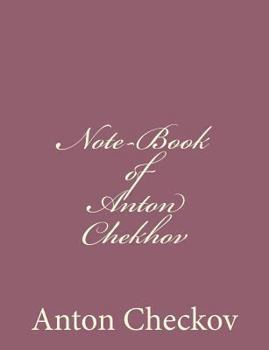Note-Book of Anton Chekhov
Select Format
Select Condition 
Book Overview
This work has been selected by scholars as being culturally important, and is part of the knowledge base of civilization as we know it.This work is in the "public domain in the United States of... This description may be from another edition of this product.
Format:Paperback
Language:English
ISBN:1494410419
ISBN13:9781494410414
Release Date:December 2013
Publisher:Createspace Independent Publishing Platform
Length:100 Pages
Weight:0.43 lbs.
Dimensions:0.2" x 7.4" x 9.7"
Customer Reviews
2 ratings
A Glimmer of Insight into the Master of the Short Story
Published by Thriftbooks.com User , 22 years ago
In 1984, The Ecco Press published a handsome thirteen-volume edition of The Tales of Chekhov that contained the respected, if somewhat dated, English translations of Constance Garnett. The original thirteen volumes were subsequently supplemented by two additional volumes, "The Unknown Chekhov: Stories and Other Writings," translated by Avrahm Yarmolinsky (a volume which is still in print under the auspices of another publisher) and the book I review here, "Notebook of Anton Chekhov," translated by S. S. Koteliansky and Leonard Woolf. Chekhov's stories are, of course, classic examples of the genre. In writing those stories, he was known (not surprisingly) to draw on numerous incidents from his everyday life. As Vladimir Nabokov relates in his "Lectures on Russian Literature," interpolating and quoting from an article on Chekhov:" 'Do you know how I write my short stories?' [Chekhov] said to Korolenko, the radical journalist and short story writer, when the latter had just made his acquaintance. 'Here's how!' 'He glanced at his table,' Korolenko tells us, 'took up the first object that met his eye--it happened to be an ash tray--placed it before me and said: "If you want it you'll have a story to-morrow. It will be called 'The Ash Tray.' " ' And it seemed to Korolenko then and there that a magical transformation of that ash tray was taking place: 'Certain indefinite situations, adventures which had not yet found concrete form, were already beginning to crystallize about the ash tray.' "Chekhov regularly recorded seemingly mundane daily incidents in notebooks and diaries and later referred to them in writing his stories. It is from this material that Koteliansky and Woolf have drawn in compiling the short (146 pages) collection of materials titled "Notebook of Anton Chekhov." While hardly an exhaustive collection of these materials, it is a useful little volume that illustrates some of Chekhov's writing habits. The diary excerpts are a mere twelve pages from Chekhov's 1896 diary. The notebook excerpts are 130 pages from the notebooks written between 1894 and 1896. As the translators note in their short introduction to this collection, "[the] volume consists of notes, themes and sketches for works which Anton Chekhov intended to write, and are characteristic of the methods of his artistic production. If he used any material, he used to strike it out in the note-book." While unfortunately out of print, "Notebook of Anton Chekhov" is a fascinating companion to Chekhov's stories, a little glimmer of insight into how Chekhov created the remarkably drawn pictures of nineteenth century Russian life that still enchant readers today.
A Glimmer of Insight Into the Master of the Short Story
Published by Thriftbooks.com User , 23 years ago
In 1984, The Ecco Press published a handsome thirteen-volume edition of The Tales of Chekhov that contained the respected, if somewhat dated, English translations of Constance Garnett. The original thirteen volumes were subsequently supplemented by two additional volumes, "The Unknown Chekhov: Stories and Other Writings," translated by Avrahm Yarmolinsky (a volume which is still in print under the auspices of another publisher) and the book I review here, "Notebook of Anton Chekhov," translated by S. S. Koteliansky and Leonard Woolf. Chekhov's stories are, of course, classic examples of the genre. In writing those stories, he was known (not surprisingly) to draw on numerous incidents from his everyday life. As Vladimir Nabokov relates in his "Lectures on Russian Literature," interpolating and quoting from an article on Chekhov:" 'Do you know how I write my short stories?' [Chekhov] said to Korolenko, the radical journalist and short story writer, when the latter had just made his acquaintance. 'Here's how!' 'He glanced at his table,' Korolenko tells us, 'took up the first object that met his eye--it happened to be an ash tray--placed it before me and said: "If you want it you'll have a story to-morrow. It will be called 'The Ash Tray.' " ' And it seemed to Korolenko then and there that a magical transformation of that ash tray was taking place: 'Certain indefinite situations, adventures which had not yet found concrete form, were already beginning to crystallize about the ash tray.' " Chekhov regularly recorded seemingly mundane daily incidents in notebooks and diaries and later referred to them in writing his stories. It is from this material that Koteliansky and Woolf have drawn in compiling the short (146 pages) collection of materials titled "Notebook of Anton Chekhov." While hardly an exhaustive collection of these materials, it is a useful little volume that illustrates some of Chekhov's writing habits. The diary excerpts are a mere twelve pages from Chekhov's 1896 diary. The notebook excerpts are 130 pages from the notebooks written between 1894 and 1896. As the translators note in their short introduction to this collection, "[the] volume consists of notes, themes and sketches for works which Anton Chekhov intended to write, and are characteristic of the methods of his artistic production. If he used any material, he used to strike it out in the note-book." While unfortunately out of print, "Notebook of Anton Chekhov" is a fascinating companion to Chekhov's stories, a little glimmer of insight into how Chekhov created the remarkably drawn pictures of nineteenth century Russian life that still enchant readers today.







